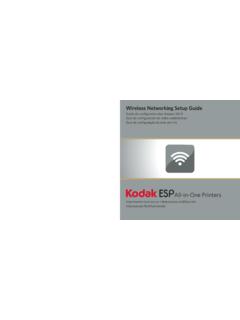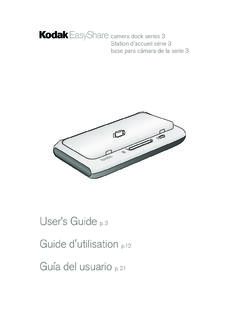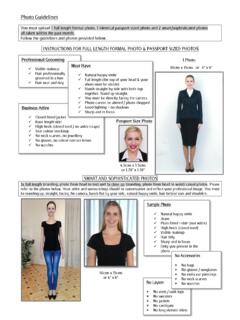Transcription of KODAK EASYSHARE C183 Digital Camera
1 KODAK EASYSHARE C183. Digital Camera Extended user guide For interactive tutorials: For help with your Camera : Eastman KODAK Company Rochester, New York 14650. KODAK , 2010. All screen images are simulated. KODAK , EASYSHARE , Max, Perfect Touch, and Pulse are trademarks of Eastman KODAK Company. 4H7065_en Product features Front view Shutter Flash button button Mode button Zoom (Telephoto, Power button Wide Angle). buttons Flash Self- timer/. Video light Lens/. Cover Microphone NOTE: To use the built-in Camera Help system, see page 39. i Product features Back view Info, Review buttons Delete, Menu buttons LCD. Strap post USB port OK button Tripod Share button socket SD/SDHC Card slot/. Battery compartment NOTE: To use the built-in Camera Help system, see page 39. ii Table of contents 1. 1 Setting up your Camera ..1. Attaching the strap .. 1. Loading the AA 2. Turning on the Camera .. 2. Setting the language and 3.
2 Storing pictures on an SD or SDHC Card .. 4. 2 Taking pictures/videos ..5. Taking 5. Using the optical and Digital zoom .. 6. Using the 7. Using different modes .. 8. Taking a video .. 10. Using shortcuts .. 10. Using the 11. Taking panoramic 12. Understanding the picture-taking 13. Know when your batteries need 13. 3 Sharing and tagging pictures ..14. Sharing pictures through social 14. Tagging pictures .. 16. Marking pictures/videos as favorites and for email .. 18. 4 Working with pictures/videos ..20. Reviewing pictures/videos .. 20. Deleting pictures/videos .. 21. Viewing pictures/videos in different 22. A smarter way to find and enjoy your 23. Understanding the review 24. Using the menu button in 24. iii Table of contents Cropping 25. Editing videos .. 26. Selecting multiple pictures/videos .. 27. Copying 28. Running a slide show .. 28. Using KODAK PERFECT TOUCH 29. Rotating 29. Displaying pictures/videos on a 30.
3 5 Doing more with your Camera ..31. Using the menu button to change 31. 6 Transferring, printing, tagging ..36. Transferring pictures to your 36. Printing 37. Marking your pictures for print .. 38. 7 Getting help ..39. Getting help from your Camera .. 39. Troubleshooting .. 40. Getting help on the Web .. 43. 8 Appendix ..44. 44. Care and maintenance .. 46. Upgrading your software and 47. Storage capacities .. 47. Important safety instructions .. 47. Battery replacement, battery life .. 48. Limited warranty .. 49. Regulatory compliance .. 51. iv 1 Setting up your Camera IMPORTANT: For package contents, see your product package. Attaching the strap 1. Setting up your Camera Loading the AA batteries Purchase cost-effective rechargeable batteries and battery charger Extend battery life see page 48. Turning on the Camera 2 Setting up your Camera Setting the language and date/time Language: to change.
4 OK to accept. Date/Time: At the prompt, press OK. to change current field. for previous/next field. OK to accept. NOTE: To change language or date/time in the future, use the Setup menu (see page 34). 3. Setting up your Camera Storing pictures on an SD or SDHC Card Your Camera has internal memory. You can purchase an SD or SDHC Card to conveniently store more pictures/videos. (Maximum supported card size is 32 GB.). CAUTION: A card can only be inserted one way; forcing it may cause damage. Inserting or removing a card while the Camera is on may damage the pictures, the card, or the Camera . 1 Turn off the Camera . 2 Insert a card. Push it until it clicks. 3 Turn on the Camera . Purchase accessories 4 2 Taking pictures/videos Taking pictures 1 The Camera turns on in smart Capture mode. (If it's in a different mode, press the Mode button, then until the LCD displays smart Capture , then press OK.). 2 Compose the picture.
5 3 Press the Shutter button halfway to focus and set exposure. When the framing marks turn green, press the Shutter button completely down. Using the framing marks Framing marks Framing marks indicate the Camera focus area. 1 Press the Shutter button halfway. If the Camera is not focusing on the desired subject, release the Shutter button and recompose the scene. 2 Press the Shutter button completely down to take the picture. NOTE: Framing marks do not appear in all modes. Multiple framing marks may appear when faces are detected. 5. Taking pictures/videos Reviewing the picture/video just taken After you take a picture/video, the LCD displays a quickview for approximately 5. seconds. (To exit the quickview sooner, press the Shutter button halfway.). NOTE: Audio is captured during video recording. Audio can be heard when the video is played on a computer or when the Camera is connected to a TV (page 30).
6 Delete the current picture/video OK Play/pause a video To review pictures/videos anytime, see page 20. Using the optical and Digital zoom 1 Use the LCD to frame your subject. 2 To zoom in, press Telephoto (T). To zoom out, press Wide Angle (W). 3 Take the picture. NOTE: For focus distances, see Specifications starting on page 44. Using Digital zoom Use Digital zoom to get up to 5X magnification beyond optical zoom when taking pictures/videos. Press Telephoto (T) until the slider on the LCD is at the end of the optical zoom range. Release Telephoto (T), then press it again. NOTE: You may notice decreased image quality when using Digital zoom. 6 Taking pictures/videos Using the flash Flash button Press the Flash button repeatedly until the LCD. displays the desired mode. Flash modes Flash fires Auto When the lighting conditions require it. Fill (Flash On) Every time you take a picture, regardless of the lighting conditions.
7 Use when the subject is in shadow or is backlit (when the light is behind the subject). In low light, hold the Camera steady or use a tripod. Red Eye Preflash A preflash fires, shrinking the eye pupil, before the Choose a setting in the picture is taken. Setup menu, see page 35. Digital The Camera digitally corrects red-eye after a picture is Correction taken. NOTE: When using Digital correction, image processing takes longer than when using preflash. Off Never 7. Taking pictures/videos Using different modes Press the Mode button, then until the LCD displays the mode that best suits your subjects and surroundings, then press OK. Mode Use this mode For smart General picture taking it offers excellent image quality and ease Capture of use. The scene is analyzed for other content and for lighting. You can choose the best picture size and aspect ratio for your needs just press the Menu button and choose Picture Size.
8 Program P Access to more manual settings than smart Capture mode. Scene Point-and-shoot simplicity when taking pictures in practically any situation. (See page 9.). Video Capturing video with sound. (See page 10.). 8 Taking pictures/videos Using Scene (SCN) modes Choose a Scene mode for great pictures in practically any situation! 1 Press the Mode button, then until the LCD displays SCN, then press OK. 2 Press to view scene mode descriptions. If the mode description turns off before you finish reading it, press OK. 3 Press OK to choose a Scene mode. SCN mode For Portrait Full-frame portraits of people. Sport Subjects that are in motion. Landscape Distant scenes. Close-Up Close range. Use available light instead of flash, if possible. Flower Close-ups of flowers or other small subjects in bright light. Sunset Subjects at dusk. Backlight Subjects that are in shadow or backlit.. Candle Light Subjects illuminated by candle light.
9 Children Action pictures of children in bright light. Manner/ Quiet occasions, like a wedding or lecture. Flash and sound are disabled. Museum Place the Camera on a steady surface or tripod. Text Documents. Place the Camera on a steady surface or tripod. Beach Bright beach scenes. Snow Bright snow scenes. Fireworks Fireworks. Place the Camera on a steady surface or tripod. Self- Close-ups of yourself. Assures proper focus and minimizes red eye. Portrait Night Portrait Reduces red eye of people in night scenes or low-light conditions. Night Landscape Distant scenery at night. Flash does not fire. Panning Emphasizing horizontal motion, keeping the subject sharp. 9. Taking pictures/videos SCN mode For Blur Reduction Reducing blur caused by Camera shake or subject motion. High ISO People indoors, in low-light scenes. Panorama Stitching 2 or 3 pictures into 1 panoramic scene. (See page 12.). (R-L, L-R).
10 Taking a video 1 Press the Mode button, then until the LCD displays Video , then press OK. 2 Press the Shutter button completely down, then release it. To stop recording, press and release the Shutter button again. To review and work with videos, see page 20. NOTE: Audio is captured during video recording. Audio can be heard when the video is played on a computer or when the Camera is connected to a TV (page 30). Using shortcuts Your Camera has a clean, uncluttered interface. For quick access to the most popular functions: Shortcuts 1 Press the Info button. The shortcuts appear. 2 Press to access functions like Exposure Compensation, Self-timer, and Auto focus. (You'll see different functions in different modes.). 3 Press to choose a setting. To hide the shortcuts, press . 10 view single picture. Taking pictures/videos Using the self-timer Use the self-timer when you want to be included in a picture, or to ensure a steady Shutter button press.














